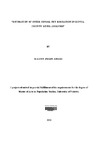| dc.description.abstract | This study entitled 'Estimation of Inter-censal net migration in Kenya: County Level Analysis' applied a non- stable population model - the Age Specific Growth Rate Technique to generate intercensal age-specific net migration rates in all Counties of Kenya. The study utilized 1999 and 2009 Population and Housing censuses data. The model was devised by Preston and Coale (1982). The empirical data was first graduated to reduce the errors associated with age reporting and then the adjusted data was used to generate the migration rates in case it had age-reporting error. The study utilized pasex computer package to compute the UN joint score and data appraisal.
The main objective of the study was to estimate net inter-censal migration rates by use of Age - Specific Growth Rate Technique in Kenya focusing on all Counties. The specific objectives were to establish the levels and patterns of internal migration in Kenya. The study found out that migration in the metropolitan areas; Nairobi and Mombasa reflected the same age-specific migration patterns, suggesting that major forces attracting the people into and/or repelling them from these two regions are nearly similar.
In-migrants in these regions that were experienced were in the age groups 5-34 for both sexes whereas out-migrants were in ages 35 years and above. In addition, the number of areas resembling metropolitan zones have is on rise examples are Lamu, Nakuru and Uasin Gishu. Migration in re-settlement areas was found to have reduced significantly where some re-settlements being senders of the population in nearly all age groups. The migration at the border areas along the international boundaries were found to register net gains in population in all ages except Counties bordering Uganda in Western Kenya.
The migration pattern in agricultural areas have changed significantly from net in-flow to net out-flow of population in almost all ages such as Kericho and in some of central Counties. The net flow of young children aged 5-9 years looking for education is observed in almost all Counties accompanied by their mothers. In the conclusion, the study computed commendable inter-eensal migration rates in Kenya by establishing the patterns and levels of migration and the general knowledge of migration patterns and typology was sound established in each and every County.
The technique distinguished net inmigration from net out-migration of different areas. However. the technique could not show which of the County was losing or gaining population to which other County. The study recommended the following:
I) a more demographic study of migration using some of modem developed technique that is vital statistics method requires to be carried out in Kenya;
2) the directional flows of population during the inter-censal period need to be revealed through development of County migration matrix. Similarly, case studies need to be intensively carried out to reveal intra-County migration by showing the patterns of migration in each and every County;
3) Motivational forces of migration in Kenya need to be investigated through both qualitative and quantitative research. | en_US |

